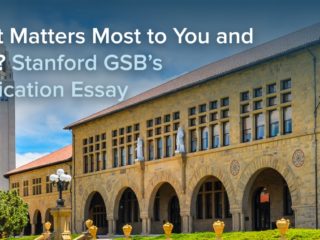| Getting your Trinity Audio player ready... |
Last Updated on August 16, 2023
The Stanford Graduate School of Business, located in the heart of Silicon Valley, one of the most competitive business environments on Earth, is not only the top-ranked business school in the U.S. but also the most selective. So, earning an impressive GMAT score can be an important way to ensure that your MBA application stands out among the pack.
In this article, we’ll take a look at the GMAT scores of students accepted to Stanford’s MBA program and some criteria for determining what score you need to be competitive.
First, let’s take a look at some key facts about Stanford’s MBA program to keep in mind when setting your GMAT score goal.
- Stanford Business School 101
- Stanford MBA Class of 2022: Key Stats
- Balancing Your GMAT Score With Other Factors
- Determining What Score You Need for Stanford
- Evaluating GMAT Section Scores
- Playing It Safe
Stanford Business School 101
A prestigious M7 school, the Stanford Graduate School of Business offers a two-year, full-time MBA program that has consistently ranked in the top 5 U.S. business schools. In fact, U.S. News ranked Stanford GSB #1 on its 2022 list of the Best Business Schools (Stanford tied with Wharton in the #1 slot in 2021). So, it’s no surprise that Stanford’s MBA program has the lowest acceptance rate of any U.S. business school.
The most recent data available shows that Stanford’s acceptance rate for its MBA program was 6.9% for fall 2019, when it admitted only 504 MBA students out of 7,342 applicants. That rate ticked up slightly from 2018, when only 6.3% of applicants were accepted. In fact, Stanford GSB is well-known for its low acceptance rate compared to other business schools; the average acceptance rate for fall 2019 at the top 10 MBA programs was 17.4%.
KEY FACT:
Stanford GSB’s acceptance rate in recent years has remained below 7%, significantly lower than that of other business schools in the top 10.
In addition to its consistently low acceptance rate, Stanford’s MBA program boasts one of the highest average GMAT scores of U.S. business schools, an average that has remained fairly steady in recent years, staying within a 5-point swing from 732 to 737. Let’s take a look at that average for the past 5 years.
Stanford MBA Incoming Classes: 5-Year GMAT Data| Incoming Year | Average GMAT Score |
|---|---|
| 2020 | 733 |
| 2019 | 734 |
| 2018 | 732 |
| 2017 | 737 |
| 2016 | 737 |
Although Stanford GSB states that it has “no preference between GMAT and GRE exams” (and no minimum score requirement for either exam), it’s important to note that 76% of the MBA class of 2022 submitted GMAT scores with their applications, while only 25% submitted GRE scores (a small number of students submitted both). So, even if Stanford has no GMAT bias, its accepted MBA students clearly do.
KEY FACT:
Stanford GSB states that it has “no preference between GMAT and GRE exams.” However, 76% of the MBA class of 2022 submitted GMAT scores with their applications.
With all of that in mind, let’s take a look at some important stats related to Stanford’s most recent incoming class, which matriculated in the fall of 2020.
Stanford MBA Class of 2022: Key Stats
The class of 2022 in Stanford’s MBA program is made up of 436 students out of 7,324 applicants to the program.
An all-time high of 47% of this elite crop of future MBAs are women, 37% are people of color, and 35% are international students. Stanford’s newest class is breaking records in other ways as well; its average GPA is 3.8, higher than any previous class’. The class of 2022 also has an average of 4.7 years of work experience, although their time in the professional world ranges from 0 to 12 years, a pretty wide swing.
The top 3 industries these MBA students hailed from were investment management, private equity, and venture capital (at 20%); consulting (at 17%); and technology (at 14%). The least common industry was manufacturing, at 2%. Lastly, as we saw earlier, this class’ average GMAT score was an impressive 733.
KEY FACT:
The class of 2022 in Stanford’s MBA program has an average GMAT score of 733 and a 3.8 average GPA, the highest average GPA in the program’s history.
Now, why is all of this data important to consider when determining what GMAT score you need to be a competitive applicant at Stanford? Shouldn’t you just shoot for the average score and be done with it? Well, the decision-making process of business school admissions committees isn’t quite so cut and dried. So, let’s talk about how your GMAT is likely to be weighed along with other factors.
Balancing Your GMAT Score With Other Factors
Undoubtedly, impressive test scores can only help when you’re applying to a top-ranked school such as Stanford, but business schools evaluate applicants holistically rather than admit applicants based on any one factor in isolation. Thus, there are numerous factors that MBA admissions committees weigh when deciding who makes the cut.
For instance, as we saw with Stanford’s MBA class of 2022, their average GPA was just as impressive as their average GMAT score. And you can bet that those students came with stellar recommendations and won admissions officers over with polished application essays, too. The truth is, a high GMAT score, on its own, isn’t a guarantee that you will gain acceptance or even be competitive at Stanford GSB, and a lower-than-average GMAT score doesn’t necessarily spell doom.
Case in point: Although the average GMAT score of Stanford’s MBA class of 2022 was 733, those students’ scores actually ranged from a low of 600 to a high of 790. What could possibly explain that 190-point swing? Well, clearly some students were exceptional enough in other areas of their applications to earn a seat despite GMAT scores that fell well below the average of accepted MBA students.
Perhaps they had impressive careers and certifications such as CPA/CA/CFA, or top-notch GPAs and advanced degrees. The point is, your GMAT is just one factor among many, so determining what score you’ll need is a matter of not only looking at GMAT averages but also carefully evaluating your strengths and weaknesses in other areas.
Of course, if your GPA is lower than the average and your work experience is lacking, an impressive GMAT score may not be enough to get your foot in the door. Remember, Stanford is at the peak of the business school mountain, so accepted MBA students are likely to be top competitors in most, if not all, aspects of their applications.
TTP PRO TIP:
Determining what GMAT score you’ll need for Stanford involves not only looking at class averages but also carefully evaluating your strengths and weaknesses in other areas.
Nevertheless, your GMAT score is an important factor in admissions decisions because MBA programs generally tend to regard the GMAT as a reliable predictor of a student’s ability to succeed in business school. So, a GMAT score on the higher end of the class range could be a “gold star” on your application.
So, how high is high enough? Should you shoot for 740? 790? Let’s investigate.
Determining What Score You Need for Stanford
Generally speaking, a good GMAT score is one that is equal to your target school’s median or average score. However, because all applicants are different, what constitutes a competitive GMAT score for Stanford varies from applicant to applicant, not only because factors such as GPA are taken into account, but also because business schools generally seek to form a diverse profile for the incoming class.
Consequently, your direct competition is other applicants whose profiles are similar to yours. Certain applicants, such as people employed in investment management or consulting, are overrepresented in MBA applicant pools at some schools — we did indeed see that those two sectors were strongly represented in Stanford’s most recent incoming class. Because people from those industries are generally overrepresented, they typically need to earn higher GMAT scores in order to stand out among their peers with similar backgrounds.
Your direct competition is other applicants whose profiles are similar to yours.
Simply put, if your profile mostly falls within the averages at Stanford — perhaps you’re a white male with 4 years of work experience in private equity and a GPA of 3.8 — then a GMAT score that is well above the Stanford average may be necessary for you to stand out among a sea of similar applicants.
In other words, you can’t assume that the average is enough, even when the average is as impressive as Stanford’s. Rather, you must take every aspect of your profile into consideration when determining what GMAT score will make you a competitive applicant. Maybe you have a GPA of 3.9 but only 2 years of work experience in an overrepresented field. Could you still get into Stanford with a GMAT score of 730? Sure. As we already discussed, several factors, not just GPA and professional experience, are weighed along with your GMAT score. However, you have to realize that many other applicants with similar profiles will probably be competing for your spot. A GMAT score of, say, 760 or 770, could significantly shrink that pool, putting you at the head of the pack rather than in the middle of it.
On the other hand, you may be from an underrepresented group and have a relatively unique personal profile, with numerous years of experience in a less represented industry, rockstar recommendations, and a 4.0 GPA. In that case, you may feel comfortable applying to Stanford with a GMAT score that falls at or below the average, perhaps a score of 720 or 710. You may, in fact, be a highly desirable candidate, in light of your overall profile.
TTP PRO TIP:
If you come from an overrepresented group, a GMAT score that beats the Stanford average may be necessary to help you stand out among a sea of similar applicants.
Of course, even if your GMAT total score falls within Stanford’s average, you also may need to consider how your score breaks down by section. Let’s discuss that next.
Evaluating GMAT Section Scores
It’s no secret that top business schools are highly quant-driven. Many programs at the top of MBA rankings pride themselves on the quantitative nature of their courses, and thus place particular emphasis on the Quant section of the GMAT, preferring to see scores of 47+. While Stanford does not publish the average GMAT section scores of admitted MBA students, the fact is, to be a competitive applicant to such a competitive program, your best bet is to devote ample time to preparing for both the Quant and Verbal sections. Nevertheless, an outstanding Quant score — or a low one — is likely to get noticed by business school admissions.
For instance, let’s say you have a GMAT score of 730 with a Quant score of 47 (or the 60th percentile) and a Verbal score of 44 (or the 98th percentile). You’re right around the average total score of admitted students, and your Quant score is by no means low, but depending on the other aspects of your applicant profile, it might be worth considering whether to retake the GMAT, with the goal of raising your Quant score.
For example, does your undergraduate record show a lackluster performance in quant-specific courses? In that case, bumping up your Quant score could help “reset the scale,” so that a couple of lower math grades in college look like a fluke instead of a pattern. Or, maybe you lack a sufficient number of quant-specific courses in your academic history. In that case as well, shooting for a higher Quant score may be a smart play, because that score will help alleviate any worries admissions might have that you won’t be able to handle rigorous, graduate-level classes focused on subjects such as finance, economics, and statistical analysis.
Your unique situation will dictate whether you think that you need a near-perfect GMAT Quant score in order to impress Stanford admissions. However, the MBA class of 2022’s GRE section scores, which Stanford did publish, may provide a small window into the thinking of admissions officers. Interestingly, the average GRE Quant and Verbal scores were nearly identical, at 164 and 165, respectively. The GRE section score ranges were also strikingly similar for Quant and Verbal, at 151 to 170 and 150 to 170, respectively.
What does this tell us? Well, at least on the GRE, the average accepted student scored just about as high in one section as he or she did in the other, and earned impressive scores overall. In other words, to be competitive at the #1 school, you’d be wise to aim for test scores that are strong all-around.
TTP PRO TIP:
To earn a GMAT score that will be competitive at Stanford, your best bet is to devote ample time to preparing for both the Quant and Verbal sections of the exam.
So, we’ve seen that what is considered a competitive GMAT score for Stanford MBA applicants is highly variable. That said, to give yourself the best shot possible at becoming one of the select few accepted to Stanford’s MBA program, you can’t go wrong by “checking every box.” Let’s talk about that next.
Playing It Safe
Unfortunately, there is no straightforward calculation that can tell you whether you’ll be accepted to Stanford with a certain GMAT score.
For one, although we know some general trends, it’s impossible to know exactly how stiff your competition will be or how large the applicant pool will be from year to year.
One additional data point we do have is that top-ranked MBA programs in the U.S. saw record application increases for matriculation in fall 2020, and that trajectory has continued for fall 2021. We also know that in times of economic uncertainty, such as during a global pandemic, more people seek out advanced degrees in order to make themselves more attractive to employers in a competitive job market.
Even without those factors at play, we’ve seen that Stanford accepts an extremely small number of people to its MBA program each year. So, when seeking admission to such a selective program, the smartest strategy is to PLAY IT SAFE.
Now, what exactly does playing it safe mean? It means that if you are from an overrepresented group or industry, you want a GMAT score that beats the Stanford average. If, on the other hand, you are from an underrepresented group or industry, you want a GMAT score that at least meets the Stanford average.
Does meeting the average mean that if you score 730 on your GMAT, but you know that you have a reasonable shot at increasing that score on a second attempt, you shouldn’t bother because you’re from an underrepresented group? Not necessarily. If, say, your practice test scores were consistently higher than the score you earned on your actual GMAT, it could be that nerves or some other issue affected your performance.
In that case, it may be worthwhile to give the GMAT another shot, so you can really make your application stand out. Additionally, if the GMAT score you submit falls toward the lower end of Stanford’s range, be aware that your test performance could become a red flag on your application. In that situation, it may make sense to devote a little more time to GMAT prep and retake the exam before submitting a score, provided you have time to do so before your deadlines.
TTP PRO TIP:
If you are from an overrepresented group or industry, shoot for a GMAT score that beats the Stanford average, and if you are from an underrepresented group or industry, shoot for a GMAT score that at least meets the Stanford average.
Luckily, a good GMAT score is one aspect of your applicant profile that is entirely within your control. If you work hard, have a smart GMAT study plan, and don’t give up, your score can be a bright spot on your application. Particularly if you need to offset weak factors in your application or distinguish yourself among a sea of applicants with similar profiles, a GMAT score that surpasses class averages could be a crucial part of convincing Stanford MBA admissions that you deserve a seat at the table.
Check out this article to learn more about what top business schools consider a good GMAT score. Need some GMAT study strategies for earning an impressive score? Our guide to scoring 700+ on the GMAT can help.



